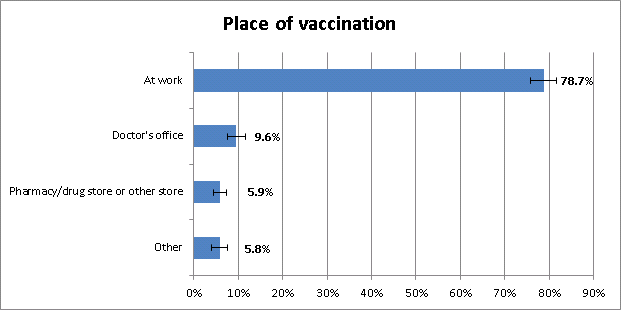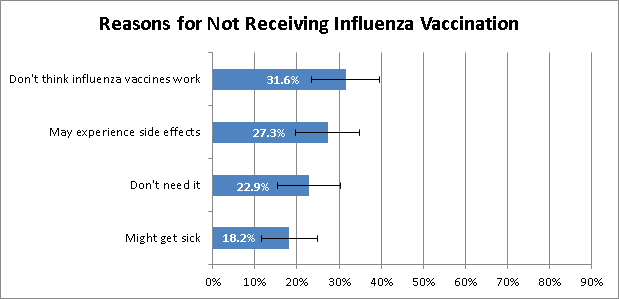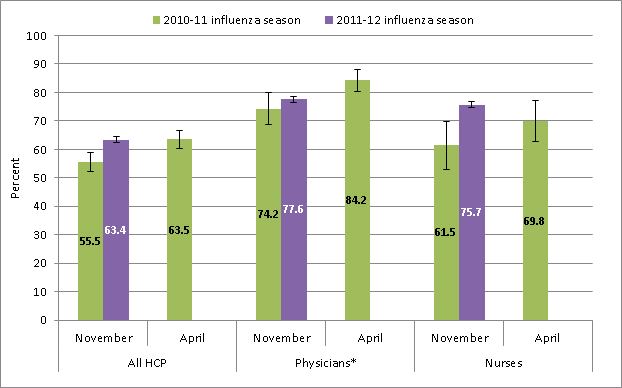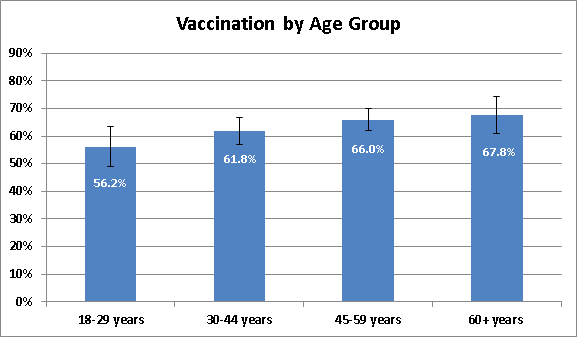Health Care Personnel Flu Vaccination, Internet Panel Survey, United States, November 2011
Authors: Megan C. Lindley, MPH; Jun Zhang, MD; Gary L. Euler, DrPH. Immunization Services Division, NCIRD
Health care personnel influenza vaccination coverage estimates by month of survey and occupation type, United States
* Physicians and dentists
Limitations, Data Source and Methods
Introduction
It is important for health care personnel (HCP) to get the influenza vaccination so they do not get sick with influenza or give influenza to their patients. Influenza vaccination has been shown to lower the number of sick days taken by HCP due to influenza (1-2), and can help HCP stay healthy so they can take care of patients when there are outbreaks of influenza. The Advisory Committee on Immunization Practices (ACIP) recommends that all HCP get an influenza vaccine every year (3). However, even though levels of influenza vaccination among HCP have risen slowly over the past ten years, less than 50% of HCP each year got the influenza vaccination until the 2009-10 season, when an estimated 62% of HCP got a seasonal influenza vaccination and an additional 2% of HCP got only the H1N1 influenza vaccination (4). Last year, in the 2010-11 season, 63.5% of HCP reported influenza vaccination (5). The national Healthy People 2020 objective for HCP influenza vaccination is 90% (6). It is important to measure influenza vaccination of HCP every season to track progress toward this objective and to make sure that HCP and their patients are protected from influenza.
Key Findings
- Influenza vaccination among health care personnel by mid- November 2011 is about 7 percentage points higher than HCP influenza vaccination by mid- November 2010—63.4% vs. 55.5%.
- Results from the April 2011 survey suggested that an additional 8% of health care personnel were vaccinated from November 2010 through the end of the 2010-11 season. If a similar proportion is vaccinated after early November this year, overall coverage will still remain substantially below the Healthy People 2020 objective for HCP influenza vaccination.
- Among unvaccinated health care personnel who did not intend to get the influenza vaccine, the most common reason reported for non-vaccination was not thinking that influenza vaccines work.
- Educating health care personnel about the safety, effectiveness, and importance of annual influenza vaccination may increase coverage levels of vaccination in this population.
Who's At Risk?
Table 1: Health care personnel influenza vaccination coverage by occupation, mid-November 2011, United States
- Influenza vaccination coverage was higher among physicians and dentists (77.6%), nurse practitioners and physician assistants (76.8%), and nurses (75.7%) compared to “other” health care personnel (58.7%).
| Population | Unweighted sample size* | Weighted n | Coverage % (95% CI) |
|---|---|---|---|
| Overall | 2,442 | 13,337,764 | 63.4 (60.7, 66.1) |
| Occupation: |
|
|
|
| Physician/dentist | 469 | 626,136 | 77.6 (73.7, 81.5) |
| Nurse practitioner/ physician assistant | 126 | 153,151 | 76.8 (69.5, 84.1) |
| Nurse | 398 | 2,814,843 | 75.7 (71.1, 80.4) |
| Other† | 1,449 | 9,743,634 | 58.7 (55.3, 62.0) |
* Seven respondents who did not provide their influenza vaccination status are excluded from this table.
† "Other" includes allied health professionals, technicians/assistants and aides, and administrative and non-clinical support staff.
Limitations, Data Source and Methods
Top of PageFigure 1: Health care personnel influenza vaccination coverage by age group, mid-November 2011, United States
- Influenza vaccination coverage varied by age, ranging from 56.2% in HCP 18-29 years to 67.8% in HCP 60 years and older.
Limitations, Data Source and Methods
Top of PageFigure 2: Health care personnel influenza vaccination coverage by work setting, mid-November 2011, United States
- Influenza vaccination coverage varied by work setting, from 45.1% among HCP working in long-term care facilities to 77.8% among HCP working in hospitals.

* ”Other” includes settings other than hospitals, physician’s offices, or long-term care facilities.
Limitations, Data Source and Methods
Top of PageFigure 3: Place of vaccination among vaccinated health care personnel, mid-November 2011, United States
- The majority of health care personnel received the influenza vaccine at their workplace.

Limitations, Data Source and Methods
Top of PageFigure 4: Main reasons for receiving influenza vaccination among vaccinated health care personnel, mid-November 2011, United States
- Protecting themselves from influenza was the most common reason reported by vaccinated HCP for receiving the influenza vaccine. Protecting friends, family, and patients from influenza were other commonly reported reasons that vaccinated HCP decided to get the influenza vaccination.

Limitations, Data Source and Methods
Top of PageFigure 5: Main reason for not receiving influenza vaccination among health care personnel reporting that they will not be vaccinated this season, mid-November 2011, United States
- Not thinking that influenza vaccinations work was the most common reason reported by unvaccinated HCP for not receiving the influenza vaccination. Other common reasons included fear of getting sick or side effects from vaccination, and not thinking that influenza vaccination was needed.

* Although 765 respondents reported not yet having received the influenza vaccine as of November 18, 2011, this question was restricted to the 226 of those respondents who stated they “will definitely not” get the influenza vaccine this season.
Limitations, Data Source and Methods
Top of PageWhat Can Be Done? (Public Health Implications)
- Influenza vaccination coverage among health care personnel (HCP) in mid-November 2011 was 63.4%, slightly higher than vaccination coverage at the same point in the previous influenza season.
- Efforts should continue to focus on educating HCP about the safety and effectiveness of influenza vaccination and its importance to prevent influenza for themselves, their friends and families, and their patients. Education targeting HCP working in non-hospital settings and HCP who work as technicians or in non-clinical positions may be particularly important. Influenza can spread rapidly in health care settings, and vaccination is the first and most important step health care personnel can take to protect against influenza.
- Offering vaccination to HCP at workplaces may increase influenza vaccination coverage among this population, since over three-quarters of HCP received the influenza vaccine at work. Offering vaccination free of charge may also increase vaccination: 20% of HCP who received the influenza vaccine said that one of the main reasons they were vaccinated was because the vaccine was offered for free.
Data Source and Methods
The data in this report were collected from two pre-existing web-based panels from November 1 – 18, 2011. Clinical personnel were recruited from the membership of Medscape, a web portal managed by WebMD Professional Services, and non-clinical personnel were recruited from Survey Spot (SSI), a general population Internet panel. There were 2,528 health care personnel who completed the screening questions and 2,449 who completed the survey. These panels were designed to recruit a sample with at least 200 participants from each of the six occupational categories, 200 participants in each of three main health care settings and 200 participants in each of three race/ethnicity groups. Survey items included self-reported vaccination during the current influenza season and vaccination history and knowledge, attitudes and beliefs concerning influenza and vaccination.
Weighted estimates were calculated based on each occupational group by age, gender, race/ethnicity, health care setting, and census region to be generalizable to the U.S. population of health care personnel. Computation of the variance of the estimates and confidence intervals assumed with-replacement sampling with unequal probability of selection for the sampling design. The post-stratification weights were used to compute the variance and confidence intervals.
Limitations
These results are preliminary and should be interpreted with caution. The follow-up survey in April 2012 will allow for assessment of influenza vaccination coverage at the end of the influenza season. Additional subgroup comparisons (e.g. vaccination coverage by race/ethnicity) adjusted for respondent characteristics will be presented using data from the April 2012 HCP internet panel survey. These internet panel survey results for HCP will be compared later to estimates from the National Health Interview Survey (NHIS).
The findings in the report are subject to several limitations. First, the sample is not necessarily representative of all HCP in the United States, because the survey was conducted among a volunteer panel of HCP rather than a randomly-selected sample. Second, all results are based on self-report and are not verified by employment records or employer interviews. Third, the survey might be subject to selection bias, if participation in the survey is correlated with receipt of vaccination or certain beliefs about influenza vaccination. Fourth, the definition of HCP used in this survey might vary slightly from definitions used in previously published surveys of vaccination coverage. Finally, estimates might not be directly comparable to those made for previous influenza seasons, because different panels were surveyed in each year. Despite these limitations, Internet panel surveys are a useful surveillance tool for timely midseason and postseason evaluation of influenza vaccination coverage and knowledge, attitude, practice, and barrier data not provided by other sources of HCP data.
Related Links
- Influenza Vaccination Distribution and Coverage, United States, 2010-11 and 2011-12 Seasons [1.4 MB, 30 pages]
- Influenza vaccination coverage estimates from a national internet panel survey of health care personnel, United States, November 2010 [326 KB, 5 pages]
- Interim results: Influenza A (H1N1) 2009 monovalent and seasonal influenza vaccination coverage among health-care personnel – United States, August 2009-January 2010
- Influenza vaccination coverage among health-care personnel – United States, 2010-11 influenza season
- Flu.gov: Health professionals
- CDC: Influenza vaccination information for health care workers
- CDC Influenza Awareness Campaign: Media Toolkit [550 KB, 23 pages]
- Follow CDC Flu on Twitter: @CDCFlu
References/Resources
- Lemaitre M, Meret T, Rothan-Tondeur M, et al. Effect of influenza vaccination of nursing home staff on mortality of residents: a cluster-randomized trial. J Am Geriatr Soc. 2009; 57:1580-1586.
- Saxen H, Virtanen M. Randomized, placebo-controlled double blind study on the efficacy of influenza immunization on absenteeism of healthcare workers. Pediatr Infect Dis J. 1999; 18:779-783.
- CDC. Influenza vaccination of health care personnel: recommendations of the Healthcare Infection Control Advisory Committee (HICPAC) and the Advisory Committee Practices (ACIP). MMWR 2006;55(RR-2).
- CDC. Interim results: Influenza A (H1N1) 2009 monovalent and seasonal influenza vaccination coverage among health-care personnel—United States, August 2009-January 2010. MMWR 2010;59 (12):357-62.
- CDC. Influenza vaccination coverage among health-care personnel – United States, 2010-2011 influenza season. MMWR 2011;60 (32):1073-77.
- Healthy People 2020. (Accessed October 21, 2011.)
- Page last reviewed: December 5, 2011
- Page last updated: December 5, 2011
- Content source:
Error processing SSI file


 ShareCompartir
ShareCompartir

